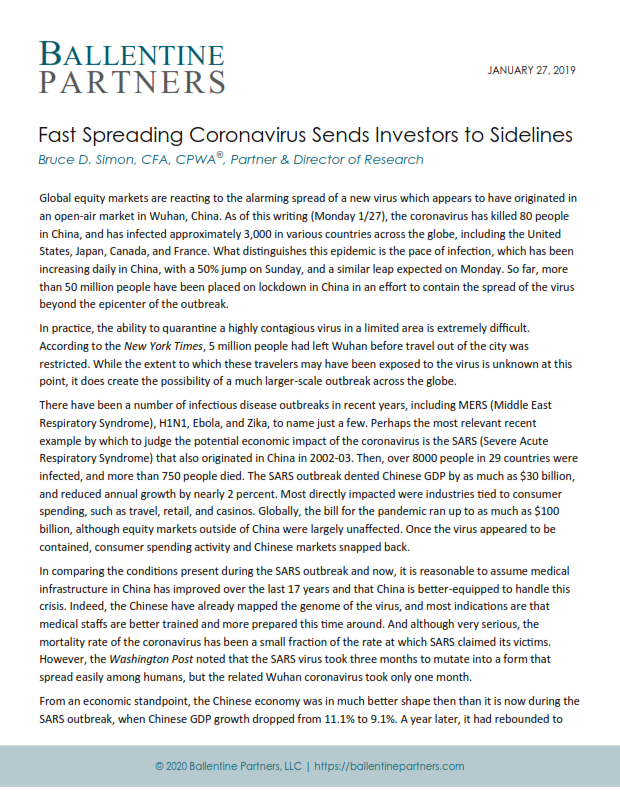Global equity markets are reacting to the alarming spread of a new virus which appears to have originated in an open-air market in Wuhan, China. As of this writing (Monday 1/27), the coronavirus has killed 80 people in China, and has infected approximately 3,000 in various countries across the globe, including the United States, Japan, Canada, and France. What distinguishes this epidemic is the pace of infection, which has been increasing daily in China, with a 50% jump on Sunday, and a similar leap expected on Monday. So far, more than 50 million people have been placed on lockdown in China in an effort to contain the spread of the virus beyond the epicenter of the outbreak.
In practice, the ability to quarantine a highly contagious virus in a limited area is extremely difficult. According to the New York Times, 5 million people had left Wuhan before travel out of the city was restricted. While the extent to which these travelers may have been exposed to the virus is unknown at this point, it does create the possibility of a much larger-scale outbreak across the globe.
There have been a number of infectious disease outbreaks in recent years, including MERS (Middle East Respiratory Syndrome), H1N1, Ebola, and Zika, to name just a few. Perhaps the most relevant recent example by which to judge the potential economic impact of the coronavirus is the SARS (Severe Acute Respiratory Syndrome) that also originated in China in 2002-03. Then, over 8000 people in 29 countries were infected, and more than 750 people died. The SARS outbreak dented Chinese GDP by as much as $30 billion, and reduced annual growth by nearly 2 percent. Most directly impacted were industries tied to consumer spending, such as travel, retail, and casinos. Globally, the bill for the pandemic ran up to as much as $100 billion, although equity markets outside of China were largely unaffected. Once the virus appeared to be contained, consumer spending activity and Chinese markets snapped back.
In comparing the conditions present during the SARS outbreak and now, it is reasonable to assume medical infrastructure in China has improved over the last 17 years and that China is better-equipped to handle this crisis. Indeed, the Chinese have already mapped the genome of the virus, and most indications are that medical staffs are better trained and more prepared this time around. And although very serious, the mortality rate of the coronavirus has been a small fraction of the rate at which SARS claimed its victims. However, the Washington Post noted that the SARS virus took three months to mutate into a form that spread easily among humans, but the related Wuhan coronavirus took only one month.
From an economic standpoint, the Chinese economy was in much better shape then than it is now during the SARS outbreak, when Chinese GDP growth dropped from 11.1% to 9.1%. A year later, it had rebounded to 11.6%. Today, Chinese GDP is closer to 6%, and with substantially higher debt levels, it is much less able to withstand a significant decline in economic activity.
At this point, it is hard to know how much more severe the coronavirus outbreak is likely to expand before it is contained. History would indicate that these types of epidemics, as painful as they can be to those affected, represent good buying opportunities for investors as the crisis subsides. But each situation comes with its own set of unique geopolitical circumstances. As Mark Twain is often reputed to have said, “History doesn’t repeat itself but it often rhymes”. Sage advice for those expecting a quick recovery in financial markets.
Learn more about Bruce Simon, our Director of Research.
This report is the confidential work product of Ballentine Partners. Unauthorized distribution of this material is strictly prohibited. The information in this report is deemed to be reliable but has not been independently verified. Some of the conclusions in this report are intended to be generalizations. The specific circumstances of an individual’s situation may require advice that is different from that reflected in this report. Furthermore, the advice reflected in this report is based on our opinion, and our opinion may change as new information becomes available. Nothing in this presentation should be construed as an offer to sell or a solicitation of an offer to buy any securities. You should read the prospectus or offering memo before making any investment. You are solely responsible for any decision to invest in a private offering. The investment recommendations contained in this document may not prove to be profitable, and the actual performance of any investment may not be as favorable as the expectations that are expressed in this document. There is no guarantee that the past performance of any investment will continue in the future.




